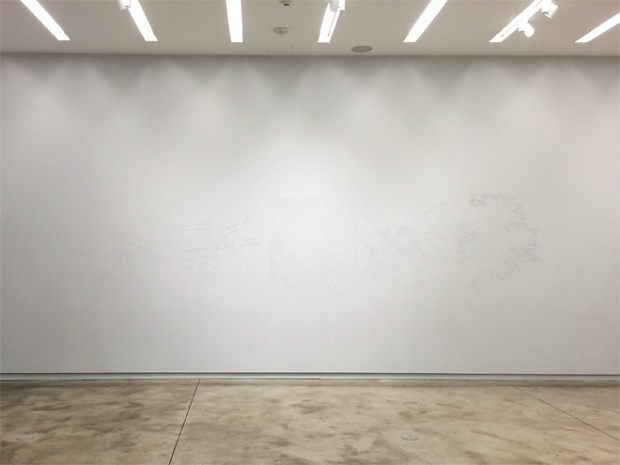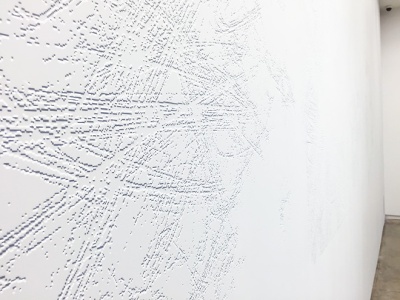The bare space of the gallery opened up with a few large installations constructed out of simple repeating materials. Less immediate was the series of five faint forms on the closest wall. This was an unusual encounter: at first glance we noticed a cluster of insignificant shadows or scuffmarks, perhaps more convincingly a shallow counter-relief of repeating patterns in the wall, made of wall. They turned out to be five large, astonishingly faint images of gestural streaks. Only one of them had delineated square edges that implied the same format for all five.

Manish Nai, Untitled, 2015, Distemper and Poster Paint on Wall, Site-Specific Mural at Kavi Gupta Gallery, Chicago, IL
Like subatomic particle collision or military data visualization, or glitch, the piece took its aesthetic qualities from both minimalist gestural brush strokes and data-driven machine art. It seemed carved into the drywall with perfect robotic precision, closely resembling an artifact of photo editing software with the same positive and negative digital transparencies slightly misaligned. The five images seemed formless without actually being so. As representations of representations, they reminded us of thumbnails with their frustrating incapability to “truly signify,” that is, inform.

Manish Nai, Untitled (detail), 2015, Distemper and Poster Paint on Wall, Site-Specific Mural at Kavi Gupta Gallery, Chicago, IL
Closer inspection shattered all of these impressions. This was a mural made of small, presumably stenciled gray and white squares, like pixels. The conversion would not have emerged without our awareness of digital image-making coupled with our shifting perspective, our movement in space. The tiny painted squares whose edges were not perfectly clean could have easily been created a thousand years ago. How could something so simple in form look so machined? This was an abstracted image, not in the typical sense of abstraction, of paring down to fundamental elements – but abstraction toward a higher complexity that increases in speed and shrinks in size. The installation spoke of the nature of our new vision, of mediation, of the way in which a thing can no longer be experienced firsthand. Everything we see is administered by the digital era with a rift between generations and a layered confusion; digital mediation has made a lot possible that we couldn’t imagine before. These abstract images ultimately collapsed upon themselves. By representing data and the complexities of information, they became images we could see and know, and perhaps even name.

Manish Nai, Untitled (detail), 2015, Distemper and Poster Paint on Wall, Site-Specific Mural at Kavi Gupta Gallery, Chicago, IL
A multitude of perspectives transformed the artwork through each moment we took to gaze, only to confound us at the point of understanding or grasping, which left a chasm between conveyance, representation, and knowing. Could it be possible that the chasm is shallow, and at the bottom lies a ravine composed of both the familiar and the potential?